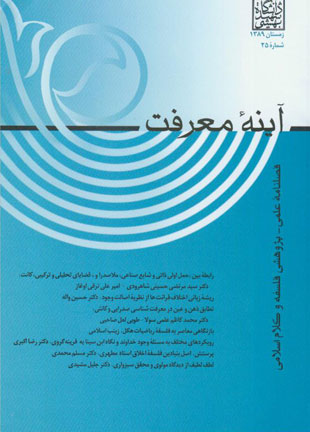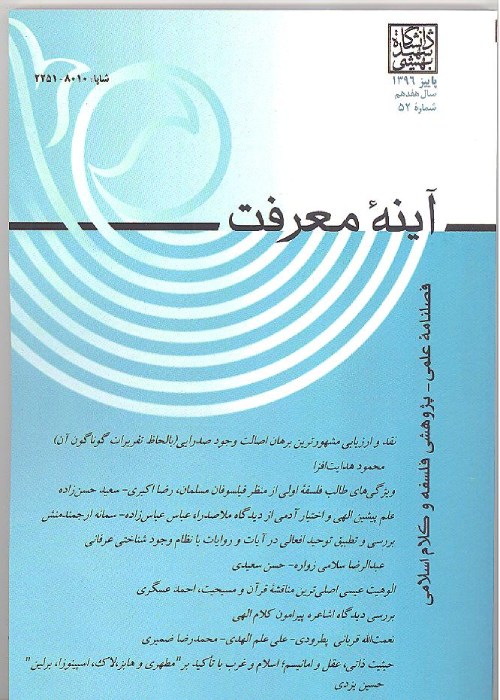فهرست مطالب

فصلنامه آینه معرفت
پیاپی 25 (زمستان 1389)
- تاریخ انتشار: 1390/10/05
- تعداد عناوین: 7
-
-
صفحه 2در این مقاله ابتدا ریشه تاریخی تقسیم احکام به تحلیلی و ترکیبی از نظر کانت و تقسیم حمل به ذاتی اولی و شایع صناعی از نظر ملاصدرا مورد توجه قرار گرفته و پس از توضیح آنها، با نگاهی تطبیقی به این دو تقسیم بندی تلاش شده است، به پرسش هایی مانند آیا قضایایی که از حمل اولی ذاتی بر خوردارند، همان «قضایای تحلیلی» هستند و آیا قضایایی که از حمل شایع صناعی برخوردارند، همان«قضایای تر کیبی» هستند و به عبارت دیگر، آیا میان این دو تقسیم بندی این همانی برقرار است یا خیر، پاسخ داده شود. برای پاسخگویی به این پرسش ها این اصطلاحات را به اجمال شرح داده ایم. در ادامه این دو تقسیم بندی را در موارد مختلف با یکدیگر مقایسه کرده، افتراق و اشتراک آنها را بیان کرده ایم و در پایان به این نتیجه رسیده ایم که این دو تقسیم بندی به رغم شباهت هایی که با یکدیگر دارند، مطابقت کامل نداشته و تشابه آنها تنها در کلیات است نه در جزئیات.کلیدواژگان: اولی ذاتی، شایع صناعی، تحلیلی، ترکیبی، حمل، حکم
-
صفحه 25بر اساس نظریه اصالت وجود، وجود اصیل و ماهیت اعتباری است. از جنبه اعتباری بودن این ادعا دو قرائت متفاوت در دست است که با همه زیرشاخه هایش، بیش از آنکه حاکی از مفروضات متفاوت باشد، ریشه در تفکیک دامنه جهت دارد، لذا اساسا زبانی است. پیامدهای متفاوت و بعضا ناسازگار این قرائت ها در مباحث فلسفی در درجه نخست، نتیجه انتخاب ناخودآگاه موضع در باب دامنه جهت است نه لازمه منطقی مبادی صدرالمتالهین که بر پایهآنها نظریه اصالت وجود استوار شده است.
کلیدواژگان: وجود، ماهیت، اصیل، اعتباری، جهت شیئی، جهت گزاره ای، دامنه جهت -
صفحه 53مسئله عینیت یکی از عمیق ترین مسائلی است که همواره ذهن عموم متفکران را متوجه خود ساخته است. دو فیلسوف برجسته اسلامی و غربی، ملاصدرا و کانت، این مسئله را به نحو عمیق تری موردکنکاش قرار داده اند. این جستار در صدد بیان این موضوع است که مسائل پیرامون معرفت در نظرگاه ملاصدرا تنها بر مبنای اصول هستی شناختی وی (ذو مراتب بودن هستی و به نحو اخص نفس انسان) و ابداعات خاصی که بر محوریت اتحاد عاقل و معقول مبتنی است از قابلیت توجیه بیشتری برخوردار است و در این راستا چگونگی و نتایج بدیع و عمیق این راه حل هستی شناختی و مقایسه آن با راه حل معرفت-شناختی کانت را پی می گیرد.کلیدواژگان: عینیت، اتحاد عاقل و معقول، وحدت استعلایی ادراک نفسانی، فعالیت ذهن
-
صفحه 85کوشش ما در این نوشتار به چند مهم خلاصه می شود. ابتدا تصویر نسبتا روشنی از فلسفه ریاضیات هگل که اندکی مهجور مانده، ارائه می کنیم؛ سپس جایگاه ریاضیات و میزان اهمیت آن را در نظام هگلی کندوکاو می کنیم و در نهایت قرائت های پنهان و آشکار عصر معاصر را مطرح و اندکی به فراخور داوری می کنیم.کلیدواژگان: ریاضیات هگل، کمیت، کیفیت، نامتناهی، کوانتوم
-
صفحه 105آیا اعتقاد به خداوند نیازمند برهان است؟ قرینه گروی معتقد است که وظیفه معرفتی انسان اقتضا می کندکه برای اعتقاد خود به وجود خداوند دلیل داشته باشد. در مقابل، ایمان-گروی وجود خداوند را بی نیاز از استدلال قلمداد می کند. حتی در برخی تقریرهای ایمان-گروی، استدلال عقلی در تعارض با ایمان دینی دانسته شده است. در فلسفه اسلامی به معنای عام آن هر دو نظریه طرفدارانی دارد. ابن-سینا را می توان یکی از مشهورترین طرفداران نظریه نخست دانست. با تامل در آثار ابن سینا متوجه می شویم که او باور خداباوران به وجود خداوند را نیازمند استدلال می داند و معتقد است که دلیل مناسب برای اثبات وجود خداوند در دسترس است و خود یکی از مهم ترین استدلال ها را در این زمینه در اختیار ما قرار می دهد. یک پرسش اساسی این است که آیا استدلال اقامه شده توسط ابن سینا استدلالی تنبه بخش نیست؟ مطالعه آثار ابن سینا به ویژه آنجا که درباره موضوع مابعد الطبیعه سخن می گوید نشان می دهد که استدلال او را باید اثبات کننده ونه تنبهی قلمداد کنیم. دلیل اشرف در اثبات وجود خداوند از دیدگاه ابن سینا مبتنی بر تامل بر اصل وجود است هر چند که دلایل دیگر را بی ارزش نمی داند، لذا شاید بتوان در ابن سینا از دلیل شخصی در مقابل دلیل کلی سخن گفت. توجه به مباحثی همچون بداهت نفس الامری قضایای بدیهی ما را به این نتیجه می رساند که قرینه گروی ابن سینا از نوع فردی است و نه گروهی.کلیدواژگان: ابن سینا، قرینه گروی، وجود خدا، برهان صدیقین سینوی، موضوع مابعدالطبیعه
-
صفحه 123استاد مطهری در میان گرایش ها و نظریات گوناگون در گستره مکاتب اخلاقی، به پرستش الهی به عنوان بنیاد اساسی مکتب اخلاقی اسلام معتقد است. مبنای دیدگاه فوق از نظر ایشان این است که هر گونه کار اخلاقی عبادت خداست حتی اگر شخص به آن توجه نداشته باشد. پرستش از نظر استاد دارای دو جنبه است باطنی یعنی سیر انسان از خلق به خالق و ظاهری عبارت است از نوع آداب و اعمالی که باید پرستش به آن شکل صورت گیرد. در این مقاله پس از تبیین هویت معرفتی و حکمت های اخلاقی و تربیتی پرستش، جنبه های معیاری آن، کنکاش خواهد شد و در نهایت به صورت مورد پژوهانه، مبانی معرفت شناسانه نظریه پرستش، مورد بحث قرار خواهد گرفت. در ادامه اثبات خواهد شدکه نظریه پرستش با توجه به دارا بودن مولفه های لازم عقلی و نقلی، می تواند یک مکتب اخلاقی - منطقی و معتدل باشد.کلیدواژگان: اخلاق، فلسفه اخلاق، نظریه پرستش، مکاتب اخلاقی
-
صفحه 147لطف خداوند، از دیدگاهی دو نوع است: تکوینی و تشریعی. آفرینش و تربیت جهان و جهانیان لطف تکوینی و ارشاد و تربیت موجودات صاحب اختیار، لطف تشریعی است. در این نوشتار، لطف اخیر مورد نظر است و آن عبارت است از اموری که آدمی را به طاعات نزدیک و از معاصی دور می گرداند، به شرط آنکه جبر و الجاء در آن نباشد. در این راستا، ضمن توجه به آراء متکلمان، جنبه های گوناگون لطف از دیدگاه مولانا و حکیم سبزواری، بیان و سرانجام، موارد توارد و تشابه یا افتراق نظر آن دو معین شده است.کلیدواژگان: نبوت، لطف، مولوی، محقق سبزواری
-
Page 25The theory of the fundamental reality of existence proposes that existence is original and essence arbitrary. This difference in interpretation with all its subdivisions, far from being a reflection of different assumptions, is resulted from the detachment of domain mode and is essentially linguistic. The different and in some cases incompatible effects of these interpretations of philosophical issues is primarily the result of taking an unconscious position toward the domain mode and not a logical requisite of Sadrolmotealehin’s principles upon which he has based his theory of the fundamental reality of existence.
-
Page 53Objectivity is one of those profound issues which have attracted the attention of almost all philosophers. The two Islamic and western philosophers, Mulla Sadra and Kant, have examined this issue. The present article argues that the way this issue has been dealt with in Mulla sadra’s philosophy has higher explanatory power due to the principles of his ontology (graduation of being and particularly of the human soul) and his initiatives such as creativity of the soul and its substantial motion and most importantly the unity of the known and the knower.
-
Page 85The present article is an attempt to first present a somewhat clear picture of Hegel’s philosophy of mathematics, which has been neglected to some extent, and then to examine the position and significance of mathematics in Hegelian philosophical system. The article, then, discusses the contemporary implicit and explicit interpretation of Kant’s philosophy of mathematics and makes its own proper judgments.
-
Page 105Does God’s existence need proof or evidence? Evidentialists believe that our knowledge duty necessitates that we provide proof or evidence that God exists. On the other hand, fideists refuse this claim and argue that God’s existence is a matter of faith. Although not every fideist sees the evidentialist claim to be in contradiction with faith, all of them are united in denying the need of proof or evidence for this central religious belief. In the Islamic philosophical tradition, both views have their own proponents. Avicenna is regarded as a well-known proponent of the first view. He believes that evidence for the existence of God is available and he himself provides us with one of the most important arguments for the existence of God.The question which arises is whether his argument is allusive or demonstrative. The study of Avicenna’s works shows that his argument should be demonstrative and allusive. From Avicenna’s perspective, the primary proof of God existence comes from contemplation on the origin of existence. Therefore, it might be possible to claim that, for Avicenna, there is a distinction between personal proof and general argumentation. The present article demonstrates that Avicenna is an evidentialist and his evidentialism is of the personal type and not the group type.
-
Page 123From among the various trends and theoretical orientations in a wide range of ethical schools, Ostad Motahari believes in God’s worship as the foundation of Islamic ethical school. From his viewpoint, the basis of the above-mentioned perspective is the idea that any moral deed is an act of God worship even if the doer is not aware of it. According to Ostad Motahari, worship has two aspects: an inward aspect which implies man’s movement from the creature to the creator; and an outward aspect which entails the type of manners and deeds upon which worship should be performed. After delineating the epistemic identity and moral and educational wisdom of worship, the present article will explore the criterion-related aspects of worship and finally will discuss the epistemological foundations of the theory of worship through a case study. Further it will demonstrated that the theory of worship can be a moderate logical school due to its having the essential intellectual and traditional elements.
-
Page 147Grace of God, from one perspective, is of two types: existential and legislative; the creation of the world and the spiritual training of its inhabitants is considered existential grace and guiding and spiritual training of the created beings endowed with free will is considered legislative grace. The present article, is concerned with the latter which implies actions that get human beings closer to obedience and move them away from sins on the condition that there would not be any compulsion in taking those actions. In this respect, with reference to philosophers’ views, first the different aspects of grace are explained from the perspective of Molavi and Hakim Sabzevri and then the similarities and correspondences as well as the differences between the two perspectives are identified and presented.


